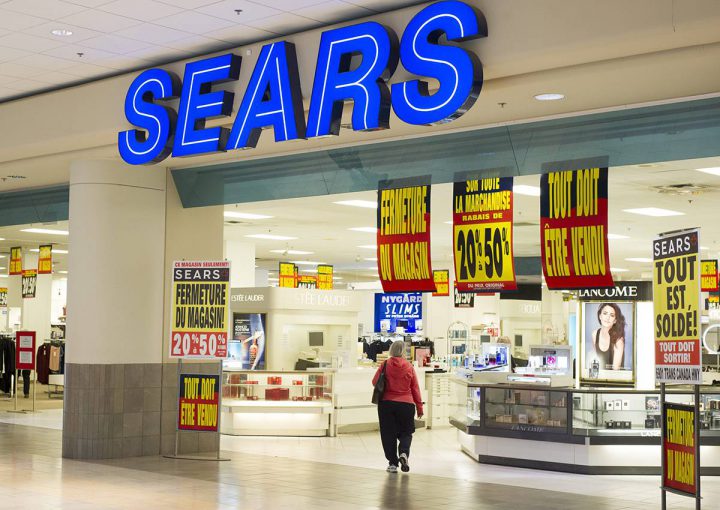The Canadian retail industry will remember 2017 with a shiver. Not one but two major big-box stores filed for bankruptcy, with Toys ‘R’ Us Canada following in steps of its U.S. cousin and Sears Canada announced it would be closing down for good after a botched restructuring attempt.

READ MORE: First Target, now Sears? Why retail jobs will keep disappearing
The rocky unravelling of Sears Canada, in particular, left Canadians agog. The bad headlines kept coming:
- 2,900 job losses that grew to 12,000
- News that laid-off employees wouldn’t get severance while executives were in line for generous retention bonuses
- The chaotic liquidation process that spurred an ongoing investigation by the Competition Bureau.
It’s no surprise that the demise of the storied department store earned the title of Canadian Press Business Story of The Year.
READ MORE: Sears Canada’s rocky downfall named Canadian Press business story of 2017
But the so-called retail apocalypse isn’t over yet in North America, according to Willy Kruh, global and Canada chair of Consumer and Retail at consultancy KPMG.
“Many Canadian retailers are not keeping pace with the fact that consumers and their shopping habits are undergoing fundamental change,” Kruh said in a recent statement.
The struggles of traditional bricks-and-mortar stores against the rise of digital sales aren’t unique to Canada, he continued. The U.S. is expected to see a record 8,600 store closings this year.
“Previously, the worst year for closures was the 6,163 stores in 2008 – and that was at the height of the financial recession,” said Kruh.
Among the high-profile casualties south of the border, besides Toys ‘R’ Us, were discount retailer Payless ShoeSource (Canadian stores were not affected), children’s clothing retailer Gymboree, popular bridal shop Alfred Angelo, and RadioShack, which filed for bankruptcy protection for the second time in a little over two years. Meanwhile, Sears Holdings announced another round of store shuttering stateside in early November.

Get weekly money news
WATCH: Pressure is on for gov’t to protect pensioners when companies go bankrupt

Millennials are teaching their elders how to shop on their phones
Some of the headwinds facing Canada’s traditional retailers are global in nature. Technological advances keep giving consumers new reasons to shop from home, the office or even the subway (internet-connection permitting) and not set foot in an actual store.
Speeding up the learning process when it comes to new shopping venues is the rise of the millennial generation and the fact that four out of 10 young people, these days, are still living with their parents, noted Kruh.
“As millennials tend to be very tech savvy that is rubbing off on their parents, which is accelerating the shift to online and experience-based shopping,” according to KPMG.
READ MORE: How online retailers’ effort to go green could ruin Christmas
Among the new gadgets that will likely move even more shopping online next year are Amazon’s Echo smart speakers and Alexa voice assistant, which the e-commerce giant released in Canada just last month.
Consumers won’t even have to click their way through a new online purchase. All they’ll have to do is tell Alexa to place an order or work through a shopping list.
WATCH: Everything you need to know about the Amazon Echo

In Canada, squeezed consumers will give retailers an extra squeeze
But Canadian retailers will face an additional challenge in 2018, said Kruh. This year may have been a rough ride for many bricks-and-mortar stores, but the economy was roaring at full throttle, and interest rates were low.
Next year will likely see slower growth. For example, RBC sees GDP growth of 1.9 per cent in 2018, which, while nothing to sneeze at, is a far cry from the 2.9 per cent expansion the economy is expected to record this year.
And that’s assuming there are no external shocks coming from the unravelling of NAFTA negotiations. The end of the trade agreement could cost Canadian retailers between $4 billion and $21 billion per year, according to a recent study conducted by global management consultancy firm A.T. Kearney in collaboration with the Retail Council of Canada.
READ MORE: Loonie down to 74 US cents if NAFTA ends — here’s what could happen to prices
Debt will also keep getting more expensive, with analysts predicting that the Bank of Canada will raise interest rates by at least another half percentage point. On top of the two hikes the central banks implemented this year, that will put rates a full percentage point above where they were in early July of 2017. With Canadians now owing $1.70 for every dollar of disposable income, that could be enough of an increase for many to have to rethink their shopping habits.
READ MORE: Your debt in 2018: The economic trends that could hit your pocketbook
“Consumers are going to be hard-pressed to keep on spending,” said Kruh.
“As consumers feel the squeeze so will retailers — especially those who need to do more to optimize the shopping experience.”








Comments